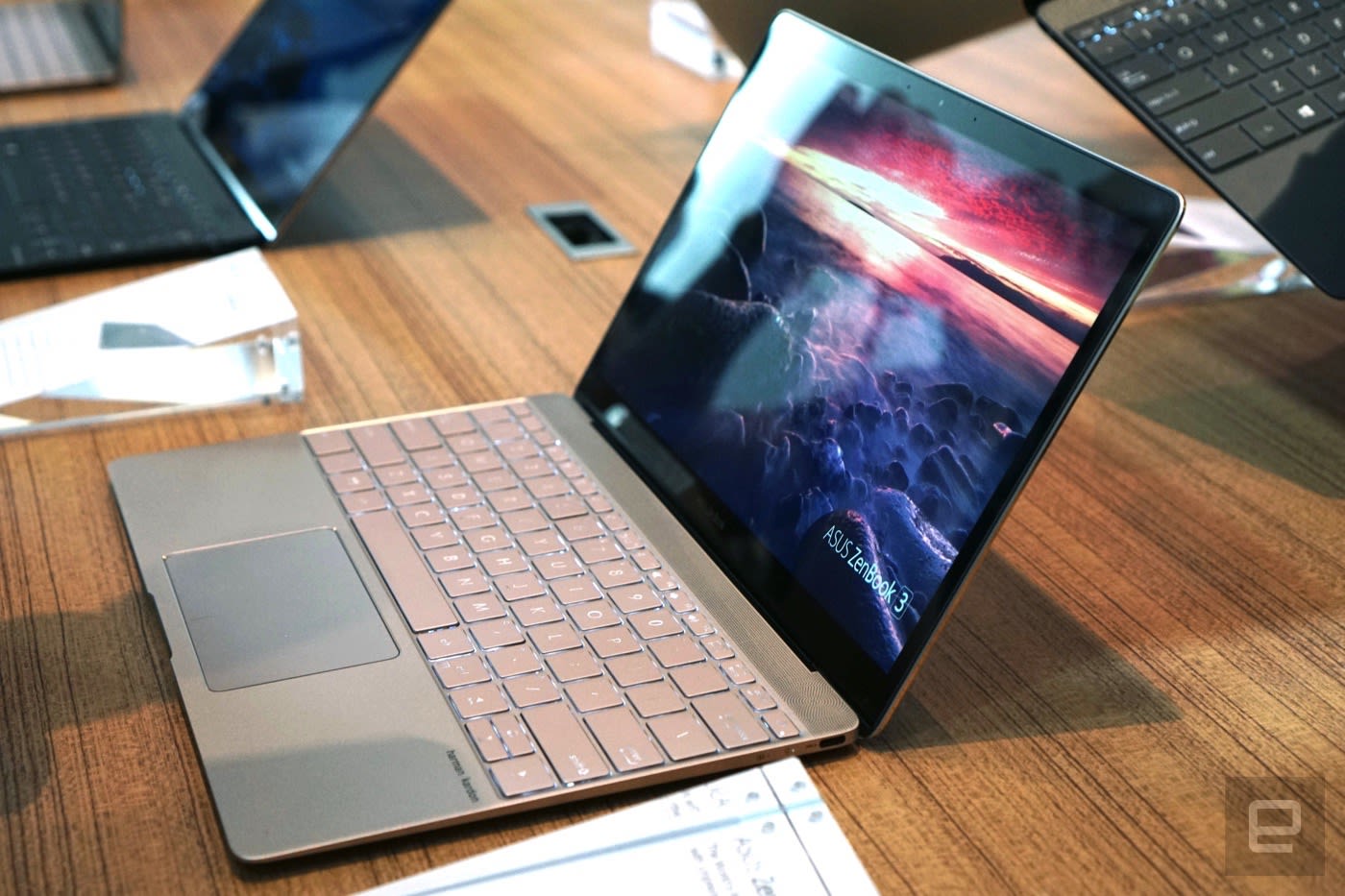
Asus is known to have a deep product portfolio and every year there are interesting refreshes. In the laptop space, there are segments which cater to the entry level user right up to the high end gamer. The ZenBook series has been at the premium edge of the Asus laptops product portfolio, concentrating on making slim ultrabooks. This segment is in its fifth generation this year and we have the Asus ZenBook 3 headlining the series. So let us have a look at this slim ultrabook and see if it indeed makes for a MacBook replacement.
Build and Design: 8.5 / 10
Asus ZenBook 3 is quite a looker. At first glance, it is quite evident that the ZenBook 3 has the Apple MacBook in its crosshairs. It sports an aerospace-grade aluminum alloy in its construction, thereby making it sturdy but keeping things light at the same time. It weighs a mere 910 grams and is only about 11.9mm thick at its thicker end since it has a tapering design. Just for comparison’s sake, the MacBook is 920 grams and measures 13.2mm.
I really liked the minimal Asus branding on top with the concentric circles around it and the golden coloured edge running along the laptop. Although I would have preferred the Royal Blue coloured model than the Rose Gold one that I had for review. It comes in a Quartz Gray colour variant as well.
On opening the flap, you are greeted with a metallic keyboard which we will discuss in detail in the next section. Above the keyboard, you have the speaker section with two front firing speakers on either ends. Then there are two more speakers which fire downward and are located under the base of the laptop. There is a 12.5-inch display with thin bezels.
If there was one thing I did not like about the ZenBook 3, then it was the presence of just a single USB Type C port. Unless Asus is planning to bundle a boat load of accessories for free with the Zenbook 3, it still carries forth the same major flaw that has been there in the MacBook as well. Let’s face it, we are still way too dependent on things such as an extra USB port for mouse and an SD card slot for transferring photos from your digital cameras (not all cameras out there are Wi-Fi enabled) and so on.
Considering the Asus ZenBook 3 houses an Intel Core i7 processor in such a thin body, it has made some modifications with regards to cooling as well. Asus uses an extremely thin 3mm thermal fan and also heat pipes which have a thickness of 0.1mm. The blades of the fan are around 0.3mm thin and made of liquid crystal polymer.
Asus has also bundled in a stylish leather case with a magnetic lock to carry around the ZenBook 3 in. Overall, it’s a stunning design, except for that single USB Type C port.
Keyboard and Trackpad: 7.5 / 10
Asus has managed to fit in a 6-row keyboard with the ZenBook 3. The keys are metallic and have just around 0.8mm of travel. This definitely takes some getting used to if you are coming from a desktop PC or a regular keyboard. For the initial couple of days, I ended up missing out on pressing certain keys while typing fast, but after using the keyboard for a longer period of time, I got used to it. And I must say, that the typing experience was quite good. There is thankfully no noticeable flex in the frame of the keyboard when you are typing fast.
The trackpad has a layer of glass atop it and is quite responsive. The clicking mechanism is quite good and it is certainly a better implementation of a single mouse button. On the top right hand corner you have the fingerprint scanner for the Windows Hello login. This does eat up into the available trackpad real-estate. This feature is optional. You can setup the fingerprint only after you have set a login password and PIN.
Features: 8 / 10
When I first saw the ZenBook 3 at Computex 2016, I was under the impression that this would be another fanless Intel Core m processor sporting slim ultrabook. But I was quite surprised to learn that it houses an Intel Core i7 7500U processor – that’s Intel’s latest generation top end processor clocked at 2.7GHz. This is paired with 16GB RAM and 512GB PCIe SSD.
It comes with a 12.5-inch Full HD display which is quite glossy. It runs on Windows 10 Home, but as is the case with most Asus laptops, the ZenBook too has a lot of custom Asus software. In terms of connectivity, you get Bluetooth v4.1, Wi-Fi 802.11ac, there’s one 3.5mm audio jack and one USB 3.1 Type C port.
Display: 7.5 / 10
The ZenBook 3 comes with a 12.5-inch Full HD display with Corning Gorilla Glass 4 protection. The display isn’t touch-sensitive, but sports wonderfully thin bezels (just 7.6mm bezels on the sides) which ensures that the ZenBook 3 has a screen to body ratio of around 82 percent, which is the highest for any Asus laptop according to the Taiwanese company. But this pales in comparison to the Infinity Display on the Dell XPS 13 though.
The ZenBook 3 comes with a 12.5-inch Full HD display with Corning Gorilla Glass 4 protection. The display isn’t touch-sensitive, but sports wonderfully thin bezels (just 7.6mm bezels on the sides) which ensures that the ZenBook 3 has a screen to body ratio of around 82 percent, which is the highest for any Asus laptop according to the Taiwanese company. But this pales in comparison to the Infinity Display on the Dell XPS 13 though.
The ZenBook 3 display looks sharp, although it is really reflective and the black bezel portion does attract some smudges. Colour reproduction is lovely, with colours really popping out thanks to the glossy finish. I felt the brightness levels could have been more.
In the Lagom.nl tests, the white level test was quite impressive showing all but the last two blocks. The black level test is a bit tricky as the display due to its glossy nature becomes mirror like, making it difficult to see the separation in top rows. This issue also crops up when you are watching movies with many dark scenes. If you are in dark room, then the experience is quite good. But let’s face it, most of the times, you will have ambient lights around you when using the laptop. In that case, you will just need to adjust the display in a manner which reduces the reflections.
Performance: 8 / 10
One of the first things that really jumped out at me was a constant buzzing sound from the moment I turned on the laptop. Turns out that the running fan which ensures things stay relatively cool, is audible even in a busy newsroom. After a point you get used to it, but in quiet rooms it can be a bit annoying. There is no way to switch this off.
One of the first things that really jumped out at me was a constant buzzing sound from the moment I turned on the laptop. Turns out that the running fan which ensures things stay relatively cool, is audible even in a busy newsroom. After a point you get used to it, but in quiet rooms it can be a bit annoying. There is no way to switch this off.
The ZenBook 3 is in the balanced mode by default and you can change those modes to maximum performance or maximum battery saving one. Intel Core i7 7500U paired with 16GB RAM ensures that everything runs smoothly on the ZenBook 3. Of course with higher end applications such as Adobe Lightroom or Photoshop, the system also heats up accordingly.
Benchmark scores are in line with some 6th gen Intel Core i7 sporting laptops. I did not notice some amount of throttling. The fans were running quite optimally to ensure that temperatures were under check. After running Prime95 for close to 15 minutes, the CPU temperature reached 72 degrees, but the temperature on the base of the laptop was around 40 degrees, a mere 7 degree rise from what it was in the idle state. Never did things get unbearably hot.
Cinebench R15 gave a score of 314 points. Transcoding an 4GB MKV file to MP4 file viewable on iPad took around 20 minutes. The 512GB PCIe SSD ensures that you get blazing sequential speeds of 1154 MB/s for read and 754 MB/s for write. For all practical purposes, this is a powerhouse of an ultrabook.
Thanks to its slim form factor, it does not have a discrete GPU, so all the graphics load is handled by the integrated Intel HD 620 graphics. While entry level games work fine, I would definitely not recommend this machine to be used for gaming.
One thing that you need to be careful about is, to always use the ZenBook 3 atop a work desk. While the lappability of the Zenbook 3 is not an issue, it is your neck vertebrae that may take the hit as you will be in a hunched posture when using the Zenbook 3 on your lap. As far as possible, avoid that.
Battery Life: 7.5 / 10
The Asus Zenbook 3 easily lasted enough for a work day which involved staying connected to the internet, emailing, streaming video and listening to music for a couple of hours, working in Google Docs and minor photo editing. Thanks to the form factor of the laptop, it is not really meant for gaming even though it can run low end games just fine. On the PC Mark 8 battery life test, we got close to four hours which is quite impressive. The laptop comes with battery saver modes as well, and you can further tweak the power settings to suit your needs. I had it set to Balanced mode for majority of the review time. Charging took a couple of hours. One thing I wished was better on the ZenBook 3 is the standby time. This is one area where the MacBook clearly has an edge, helped a lot by the fact that it uses a low power Intel Core m processor.
Verdict and Price in India
The Asus ZenBook 3 is an excellent compact ultrabook with really top end specs in a well designed body. It is priced at a premium at Rs 1,47,999. So clearly, it is looking a very niche market segment. I just wish there were more USB Type C / Type A ports or at least an SD card slot. Yes, some may also complain about the display not being QHD+, but honestly I didn’t find that to be much of an issue.
The Asus ZenBook 3 is an excellent compact ultrabook with really top end specs in a well designed body. It is priced at a premium at Rs 1,47,999. So clearly, it is looking a very niche market segment. I just wish there were more USB Type C / Type A ports or at least an SD card slot. Yes, some may also complain about the display not being QHD+, but honestly I didn’t find that to be much of an issue.
If you are invested in the macOS, then between the MacBook and the ZenBook 3, the latter makes more sense from a performance perspective. Else you can opt for a similarly priced MacBook Pro 2015.
If you want a Windows alternative to the MacBook, then the ZenBook 3 is the only option at the moment along with the HP Spectre (but this comes with 6th gen Intel processor and 8GB RAM). If you want a more robust premium ultrabook, then you can check out the Dell XPS 13 which offers two USB 3.0 ports and an SD card slot. The XPS 13 with a 6th gen Intel Core i7 processor is priced around Rs 1,33,000 and can certainly ruin the Asus ZenBook 3’s party.
If you do not want the top end ZenBook 3 variant, you can check out the Intel Core i5 model with 8GB RAM and 512GB SSD which is priced at Rs 1,13,990 or the Intel Core i7 model with 8GB RAM and 512GB SSD priced at Rs 1,23,990.












No comments:
Post a Comment